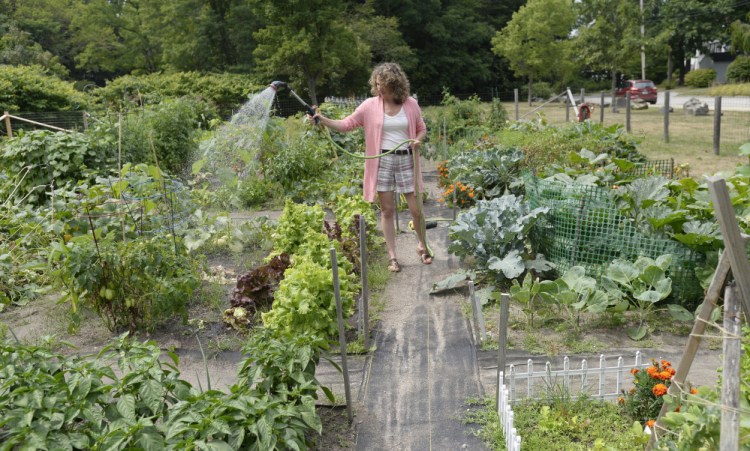This summer’s drought – the second straight year coastal Maine has dealt with a shortage of rain – snuck up on us.
We started the year with a plentiful snowpack, rain was above normal in April and May and about normal in June.
“People were complaining about it being too wet to get on the fields to plant crops and cut hay,” said Glen Koehler, a fruit-tree specialist with the University of Maine Cooperative Extension in Orono.
In late June, it stopped raining along the coast – although weather forecasters kept predicting thunder showers. Those showers provided some heavy rain for the inland mountains and foothills but dried up before hitting the coast.
Now some statistics: As of August 15, Portland’s rainfall deficit is approaching 5 inches. It’s just an inch or so over the all-time driest June 1 to August 15 on record, according to meteorologist Dave Epstein. As he wrote recently in the Press Herald, “it’s dry out there.”
There was nothing sneaky at all about the drought of 2016. It started with a meager snowpack and continued with rain much below normal through the growing season until some fall rains provided relief for the aquifers and wells before winter set in. Trees and other plants that couldn’t be irrigated turned brown.
Another factor has tempered the severity of this year’s drought, as Koehler explained. “The temperature this year been a little below average,” he said, “and moisture stress is highly affected by higher temperatures.”
In 2016, temperatures were warmer than average.

Dry leaves on a nannyberry tree in Saco on Tuesday.
OK, so we’re not as bad off as last summer, but that’s not to say we’re home free.
“As far as wild plants go,” said Bill Cullina, president and chief executive officer of Coastal Maine Botanical Gardens in Boothbay, “two years of drought is especially hard on trees and creates stress that makes them more vulnerable to disease and cold damage.”
Cullina added that while the early-season rain this year was a benefit overall, it has a downside: The foliage on many plants was lush and soft from the early rain so suffered more damage than it might have otherwise when the rain stopped.
The botanical gardens have an efficient drip-irrigation system for much of the property, but for areas without irrigation they have had to water by hand or let the plants turn brown.
A drought like the one we are having this year harms newly planted specimens more than it does established plants. Allie Pierson of Pierson Nurseries, a wholesale dealer in Biddeford and Dayton, said that the nursery waters all of its plants every day. The staff advises purchasers to continue daily watering at first, and then wean them off the daily watering slowly so the new plants aren’t so water-dependent when they are placed in the landscape.
With the expansion underway at the botanical gardens, many new plants have been installed this year, Cullina said, and they require frequent hand-watering – as the irrigation system is not yet in place – which takes hours every day to accomplish. Both Pierson and the botanical gardens have water on site – aquifers at the gardens and aquifers and retaining ponds at Pierson – so frequent watering doesn’t cost more than the electricity to run the pumps, which Cullina described as insignificant.
OK, so that’s what the professionals are doing about the drought. Now what should you do on your property?
“We tell people they should do what they want, based on their comfort level,” said Kookie McNerney, a home horticulture coordinator at the extension’s Cumberland County office.
Your established lawn, herbaceous perennials, shrubs and trees are not going to die as a result of the so-far-moderate drought that we have had this season. Yes, the lawn will go brown and dormant, but it will green up again if we have fall rains, McNerney said. Perennials may die back earlier than normal, but they will come up again next spring. Trees and shrubs may go brown and drop their leaves early, but will survive.
But if you want to water, go ahead. But do it properly.

Jodi-marie McCarthy of Saco waters her garden plot at the Saco Community Garden.
Water at ground level, preferably using drip irrigation. Watering from overhead, as with traditional sprinklers, gets the leaves wet and allows some fungal diseases to form. Water early in the day, and especially avoid watering in the evening so the plants don’t stay wet all night, which also promotes fungal disease. McNerney said she is seeing quite a few rust and fungus diseases this year as a result of improper watering.
On a personal note, I was a bit embarrassed when my column on the mid-season status of my wife and my gardens appeared. In it, I wrote that I had yet to drag out the sprinklers and that our rain barrels had not gone dry. That was all true when I wrote the column on July 20. Although we had gone a couple of weeks without rain at that point, showers were in the forecast, so I wasn’t worried.
But by the time the column appeared in print and online 10 days later, those showers still had not materialized. Nor have they as of my writing this column on Aug. 13. I have since irrigated our entire property, and the rain barrels have gone dry. Also, I have been regularly hand watering all our flower containers, the shrubs we planted this year and the tomatoes, peppers, cucumbers and squash. We have now sprinkled our entire property twice, and we will have irrigated a third time by the time this column appears – unless we get significant rain between now and then.
Tom Atwell is a freelance writer living and gardening in Cape Elizabeth. He can be contacted at 767-2297 or at: tomatwell@me.com.
Send questions/comments to the editors.



Comments are no longer available on this story